Standards Worldwide
Standards Worldwide
Phone +49 30 58885700-07

Standard [CURRENT]
ASTM E 582:2021
Standard Test Method for Minimum Ignition Energy and Quenching Distance in Gaseous Mixtures
- German title
- Bestimmung der Mindestzündenergie und des Löschabstandes für Gasgemische
- Publication date
- 2021
- Original language
- English
- Pages
- 6
- Publication date
- 2021
- Original language
- English
- Pages
- 6
- DOI
- https://dx.doi.org/10.1520/E0582-21
Product information on this site:
Quick delivery via download or delivery service
Buy securely with a credit card or pay upon receipt of invoice
All transactions are encrypted
Short description
1.1 This test method covers the determination of minimum energy for ignition (initiation of deflagration) and associated flat-plate ignition quenching distances. 2 The complete description is specific to alkane or alkene fuels admixed with air at normal ambient temperature and pressure. This method is applicable to mixtures of the specified fuels with air, varying from the most easily ignitable mixture to mixtures near to, in theory, the limit-of-flammability compositions. Note 1: The test apparatus described in Section 4 is not suitable for near limit mixtures. Near limit mixtures require a much larger test volume (that is, reaction vessel), and the capability for producing much larger spark energies. 1.2 Extensions to other fuel-oxidizer combinations, and to other temperatures and pressures can be accomplished with all the accuracy inherent in this method if certain additional conditions are met: ( a ) mixture stability and compatibility with bomb, seal, and other materials is established through time tests described in Section 9 ; ( b ) the expected peak pressure from the test is within the pressure rating of the bomb (established as required by the particular research laboratory); ( c ) spark breakdown within the bomb is consistent with Paschen's law for the distance being tested; ( d ) the temperature, including that of the discharge electrodes, is uniform; and ( e ) if the temperature is other than ambient, the energy storage capacitance required is less than about 9 pF. 1.3 This method is one of several being developed by Committee E27 for determining the hazards of chemicals, including their vapors in air or other oxidant atmospheres. The measurements are useful in assessing fuel ignitability hazards due to static or other electrical sparks. However, the quenching distance data must be used with great prudence since they are primarily applicable to the ignition stage and therefore, represent values for initial pressure and not the smaller values existing at higher pressures. 1.4 The values stated in inch-pound units are to be regarded as standard. The values given in parentheses are mathematical conversions to SI units that are provided for information only and are not considered standard. 1.5 This standard should be used to measure and describe the properties of materials, products, or assemblies in response to heat and flame under controlled laboratory conditions and should not be used to describe or appraise the fire hazard or fire risk of materials, products, or assemblies under actual fire conditions. However, results of this test may be used as elements of a fire risk assessment which takes into account all of the factors which are pertinent to an assessment of the fire hazard of a particular end use. 1.6 This standard does not purport to address all of the safety concerns, if any, associated with its use. It is the responsibility of the user of this standard to establish appropriate safety, health, and environmental practices and determine the applicability of regulatory limitations prior to use. Specific safety precautions are listed in Section 5 . 1.7 This international standard was developed in accordance with internationally recognized principles on standardization established in the Decision on Principles for the Development of International Standards, Guides and Recommendations issued by the World Trade Organization Technical Barriers to Trade (TBT) Committee.
ICS
71.100.20
DOI
https://dx.doi.org/10.1520/E0582-21
Loading recommended items...
Loading recommended items...
Loading recommended items...
